How to Paint: The art of painting is a head game. It requires a distraction-free environment that allows you to get into the painting zone and lets things go smoothly.
Distractions are the enemy of the painter.
Here are some ways to keep your head in the game by using tools to eliminate distractions and help you stay focused on painting — including some cool products we’ve recently played with.
- Lay Out Your Palette the Same Way Each Time
Your palette needs to be like the keyboard of a piano, so you always go to the same spot to find what you need, until you can do it instinctively. No matter how you lay out your colors, make a point of always putting them in the exact same places and in the same order. Though there is no right or wrong way to do this, many artists believe colors should be laid out from warm colors (reds and yellows) to cool (blues and greens), with white either in the middle or on an edge, but in the same spot every time.

- Instant Painting Tricks
I’ve sometimes been discouraged when I wanted to walk in and start painting, but had to take time to lay out my colors. There are many options and products to make setup easy and quick for either studio or outdoor painting.
One option is to keep your oil paints on a glass palette and store it in a tub of water between painting sessions. Oil and water don’t mix, so this works great with oil paints; you can simply pull the palette out of the water and start painting. Another option is to place your palette in the fridge or freezer.
You can also keep your palette inside a plastic box with an airtight lid; there are many made just for artists’ palettes and palette paper. Artist Joe McGurl uses a plastic watercolor palette that has small compartments for paint. When he’s done painting, he simply puts the airtight lid on the palette.
(See photo above.)
One new product, the Palette Garage, allows you to pull out paints when you need them and then store them away easily when you’re not using them. And artist Camille Przewodek developed a product called a Paint Saver Palette, which has an airtight cover so you can store unused paint on the palette itself.
One homebrew solution is to put paint in vitamin holders, which have individual compartments with lids to keep your paint from drying out.
[Learn how to paint from the comfort of your home with Streamline Premium Art Videos!]
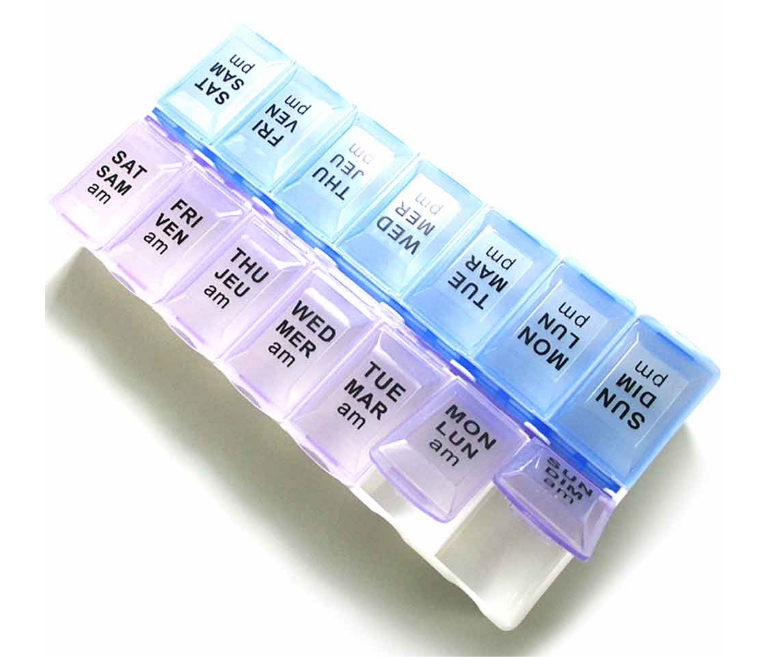

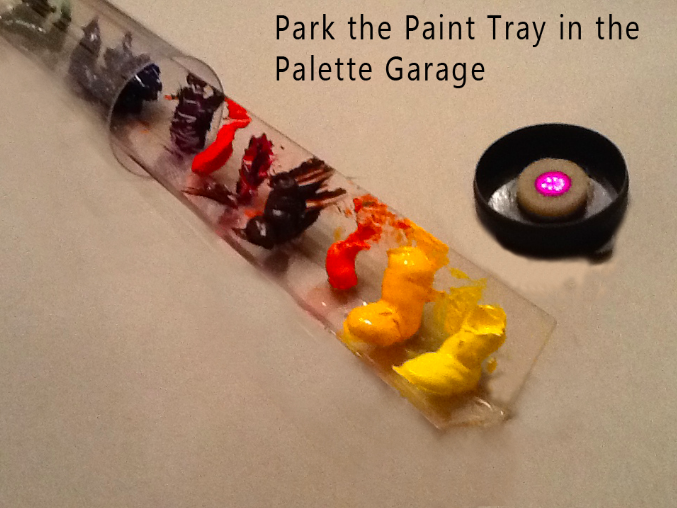
- Paint Tube Organization Tricks
Though of course you’ll have paint on your palette, if you run out, your paints need to be easy to reach so you don’t burn time looking through piles of tubes. One thing I’ve noticed is that the real pros tend to put out a lot of paint. Large piles of paint typically prevent them from having to break their flow while they’re working. Always consider putting out more paint than you think you’ll need.
You can easily waste five minutes looking for a single misplaced tube of paint, so it’s a good idea to keep frequently used paints in a drawer or other spot that’s easy to get to, and always keep them in the same order. If you take a tube out, be sure to put it back in exactly the same place.
Many painters mark the color names over storage drawers, or even put a swatch of paint on the drawer itself, making specific colors easy to find. Painters can pick up organization units at bed and bath or container stores. It’s also a good idea to have a standardized palette so the most used colors are always easy to access. Less used “rogue” colors need to be in their own places as well.
A couple of new products can make this easier. Craftech makes a palette with a built-in tube-storage drawer (it’s on my wish list), and the Rembrandt paint company makes a tube holder that you can hang up for storage.



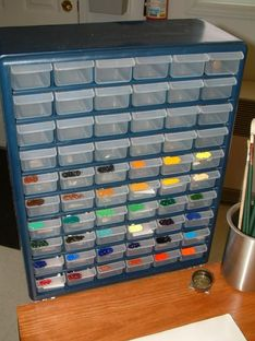

- Make Your Palette Work for You
Each artist has a preference for the type of palette they use. Some use a glass palette on a table or taboret in front of or beside their easel. Others use palette paper, which comes in white, gray, and even wood tones (palette paper is great for easy cleanup). Many artists use a handheld palette so they can hold it up to match the color mixture while looking at the subject or model.
There are pros and cons to each, so it’s important to find what works best for you and stick with it until it becomes part of that “keyboard.”
One thing to consider is that palettes on a table below or beside the easel are not in the same light plane as your canvas, meaning it’s possible that you’ll mix colors darker than you want. But there are ways to get the palette into the same light plane as the painting — as noted above, this is why many artists use handheld palettes, so they can see the color in the same plane as the canvas and the subject. But continually holding up a palette can be tiring, which is why I like having the palette in a fixed place beside my easel.
Some artists, like Steven Assael, lay their paints out on the edge of the canvas and mix on the canvas itself. But there are easier ways, like the Parallel Palette, created by artist John David Kassan. This gray plastic palette mounts next to your canvas with a tripod connection, holds the paint at the top, and provides a mixing space. Best of all, it’s in the same light as your painting. This is an excellent tool I use often.
Another option is to mount your handheld palette beside the painting using a clip of the kind you can find at a hardware store. Unless the paint is especially oily, it will not slip off or run.

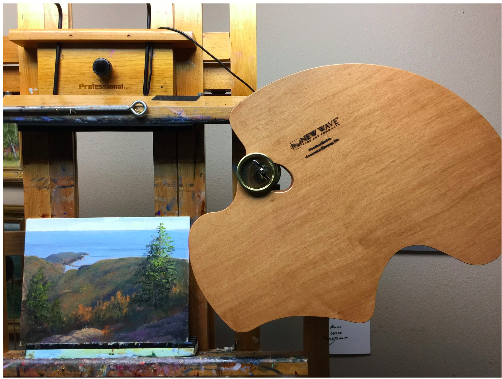
- Creating Premixed Piles of Paint
Premixing colors is also a time saver. Before starting your painting, look at the big masses of your subject, determine the primary color you’ll be using most (sky, mountain, water), and mix a big batch. We tend to mix in small batches, then have to remix to match the color we just ran out of. Mixing big piles of the most used colors will save you lots of time. Artist Ken Auster was famous for making big piles of paint.
- Instant-Access Mahl Sticks
Other items that distract painters include less frequently used tools like mahl sticks (which are used for supporting the arm or hand when strokes require a steady hand). Rather than searching for a mahl stick when you need it, you can add a hook to the end of the stick and hang it from your easel. That not only keeps it in easy reach when it’s needed, having one end anchored helps keep the stick itself steadier.
I first saw this trick when I was watching an artist copy a Vermeer work at a museum in Europe: The mahl stick rests on a screw or eyelet at the side of the easel, so it’s always at hand and easy to grab when needed. I find I use the stick more when I have it mounted to my easel.


- Paper Towels for a New Perspective
Paper towels are a much used item among artists. Some artists intentionally keep their towels at the back of the room, so when they go back for a fresh towel every few minutes, they are forced to gain some distance and perspective. But if you’re keeping towels close, they can be held by a simple bungee cord attached to your easel tray, or a paper towel holder mounted on your easel.
- Keep Tools Consistent
Just as paints and brushes always need to be in the same spot, your mineral spirits should always in the same place so you can dip without looking. Your mineral spirits or brush cleaner can be stored in a container hanging from your easel, or some easels have cutout holes where you can drop in a container. Smaller cups for painting mediums are best suited for your palette or the tray of your easel.
- Magnets as Painting Tools
I’ve mounted a magnetic plate to my easel, allowing me to keep my metal razor-blade scraper in the same place every time. I used to put the scraper down in different places, often dropped it on the ground or floor, and had to spend time searching for it before I could clean my palette. I also find this helpful when using steel palette knives. I can place them on the magnet and always find them when I need them.
Edge Pro Gear’s Paintbook line of easels have magnetic trays that hold a magnetic mineral spirits can, so you’re less likely to knock over and spill your spirits. Edge Pro also makes magnetic painting panels that stick instantly to their magnetic easels.
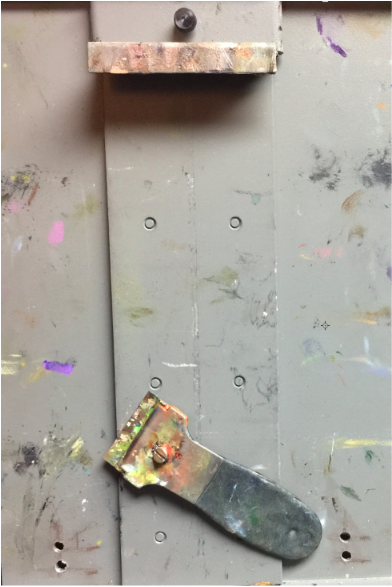

- Keep Your Brushes Easy to Grab
Brush organization is probably the most critical of all, because brushes are your most used tools. Before painting, it’s important to anticipate the brushes and knives you’ll be needing so you don’t have to spend time looking during active painting time. That can break your stride, especially if you’re like me and have lots of cans of brushes.
How many times have you needed a specific brush for a specific purpose and been unable to find it? Soon you find yourself digging through piles and jars full of brushes, looking for the right one.
Though most artists keep a giant jar with a lot of brushes nearby, finding what you need quickly in that environment can be difficult. One of the best ways to be effective is to keep brushes within view, beside your painting, so you can grab exactly what you need at the moment you need it.
It’s also important to be able to sort your brushes in various ways, depending on your style of painting. For instance, some painters like to use clean brushes for certain passages so that a dirty brush doesn’t stain a clean sky or a clean color, or a light color won’t contaminate a darker one.
Other painters tend to reserve separate brushes for cool colors and warm colors. They understand that putting a brush with even a little warm paint residue into a cool color can “spoil” that cool color. (The opposite is also true.) Artists need an easy system to deal with warm/cool or clean/dirty brush issues to avoid unwanted mingling of paint.
Though most easels have trays and most artists have a table or taboret to hold their palette, brushes, colors, and mineral spirits or water, these surfaces can easily become cluttered. And while laying out brushes makes them much easier to find than sorting through a jar, loose brushes are easily bumped and knocked off a table.
- New Tools to Keep Your Brushes Organized
Bending down or crawling on the floor or the ground to look for a lost brush not only eats time, it breaks the artist’s concentration. Dropped brushes pick up dust (or dirt or mud outdoors), and they can be damaged if they fall on the hairs. Wet-paint-filled brushes fall on your studio floor, which then has to be cleaned, and artists have been known to go to the floor or ground and bump their heads or knock their easels over when coming up. And of course some artists prefer to avoid bending down altogether.
A new product that has surfaced in the past year seems to address many problems with brush management. It’s one of those products you won’t think you need until you see the silly little video clip. The product, called an Easel Brush Clip, has two small, square cups held together by a clip, and it easily clips to the palette at eye level, next to the painting. This allows the artist to find brushes easily. Because there are two cups, they can be used to keep warm and cool brushes apart, or used and clean brushes. We’ve found that artists are placing a couple on each side of their easels so all the brushes they need are easily found.

This product also allows the painter to easily drop in a brush she intends to return to momentarily without having to hold on to it, and it’s a natural place to put brushes rather than laying them down. Of course, the great side benefit is that brushes are a lot less likely to hit the ground!
These clips are also popular with outdoor “plein air” painters who want to keep brushes off of small, often flimsy trays and prevent knocking them on the dirty ground or having them roll into their paints. Further, the clips keep brushes in view and in easy reach; in plein air painting, finding a place for brushes is always a challenge. Outdoor artists have also discovered that the strong clip can be used to hold painting umbrellas and paint-rag bags. Artists are using these clips in their studios and as part of their outdoor painting rigs, to hold brushes, palette knives, and even for storing items like eyeglasses.

12. Keep It Consistent to Avoid Distractions
All artists eventually develop systems of their own to manage their tools. What is most important is to find what works for you, and then to keep things in exactly the same order every time, so your focus is not broken and you’re not getting frustrated when you should be painting. You’ll find that you’ll paint better when little distractions are no longer disturbing your concentration.
Visit EricRhoads.com to find out all the amazing opportunities for artists through Streamline Publishing, including:
– Online art conferences such as Plein Air Live
– New video workshops for artists
– Incredible art retreats
– Educational and fun art conventions, and much more.
> Subscribe to Plein Air Today, a free newsletter for artists
> Subscribe to PleinAir Magazine so you never miss an issue

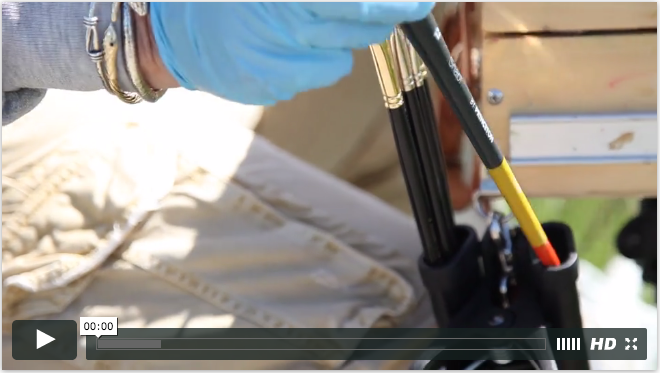
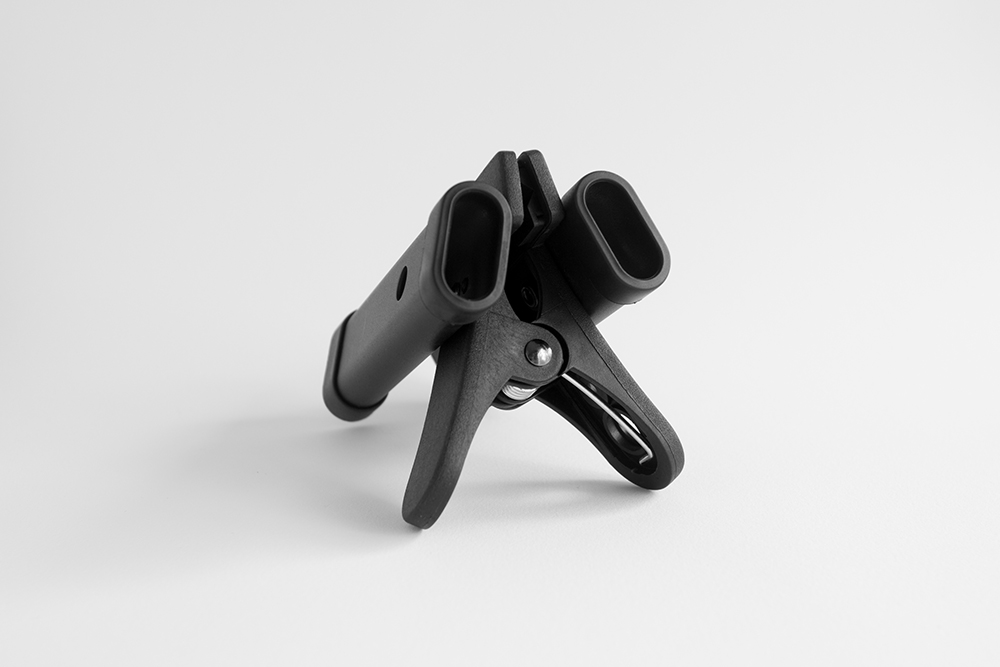





[…] https://www.outdoorpainter.com/12-ways-artists-can-reduce-frustration-while-painting/ […]
I USE VITAMIN HOLDERS TO HOLD PAINT AS WELL! For watercolor on the go, I also use an old makeup box and a foldable doggy bowl. Great article with great recommendations! Something I would add is https://nuuuk.com/ their product really helps me minimize the mess on my art table and on the go. I really enjoy it and hopefully this would help anyone with similar art problems.
Very ergonomic suggestions for artists. I am not sure about the vertical palete of David Kassan, but who maybe it can improuve the speed of working.
just discovered your very friendly site and forum while I was looking for a soft carrier for my watercolours. You know something which can roll up-a little bit like a canvas paint brush holder.
I’ve spent a bit of time on it today and seen that a company called Tran, in Columbia,
produce a small one.
The problem is that I’m in England and will be very pleasantly surprised if I can find a
company who are willing to post outside if the U.S.
as a paint tube carrier it seems a great idea, also for organisation, just surprised its so hard to get my hands on one.
thanks for reading,
David
(in Surrey)
David, I purchased the Trans carrier for oils, actually from ebay instead of Amazon. I am in the US. You might talk to a local seamstress. She could probably sew one for you if you made a sketch with the measurements.
Valuable suggestions, especially for a beginner.
Would love to find that rollup paint tube holder (Rembrandt?). Looked online and I came up blank. Any advice?
Canadian painter
Where can I find the Rembrandt paint tube holder you have displayed. Having great difficulty finding it.
Daveliou Paint Organizer, 1.35 fl oz (40mL) Paint Tube Holder and Roll Up Case (24 Slots) https://a.co/d/9nB47lj
This looks similar